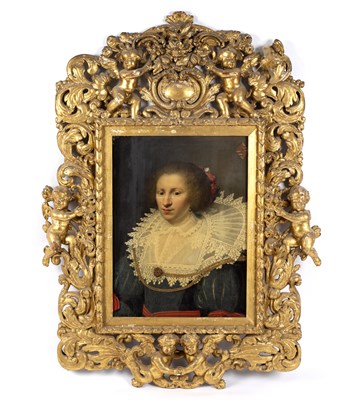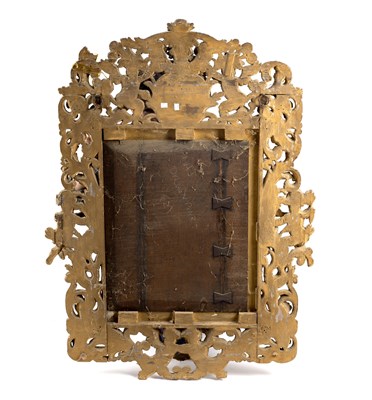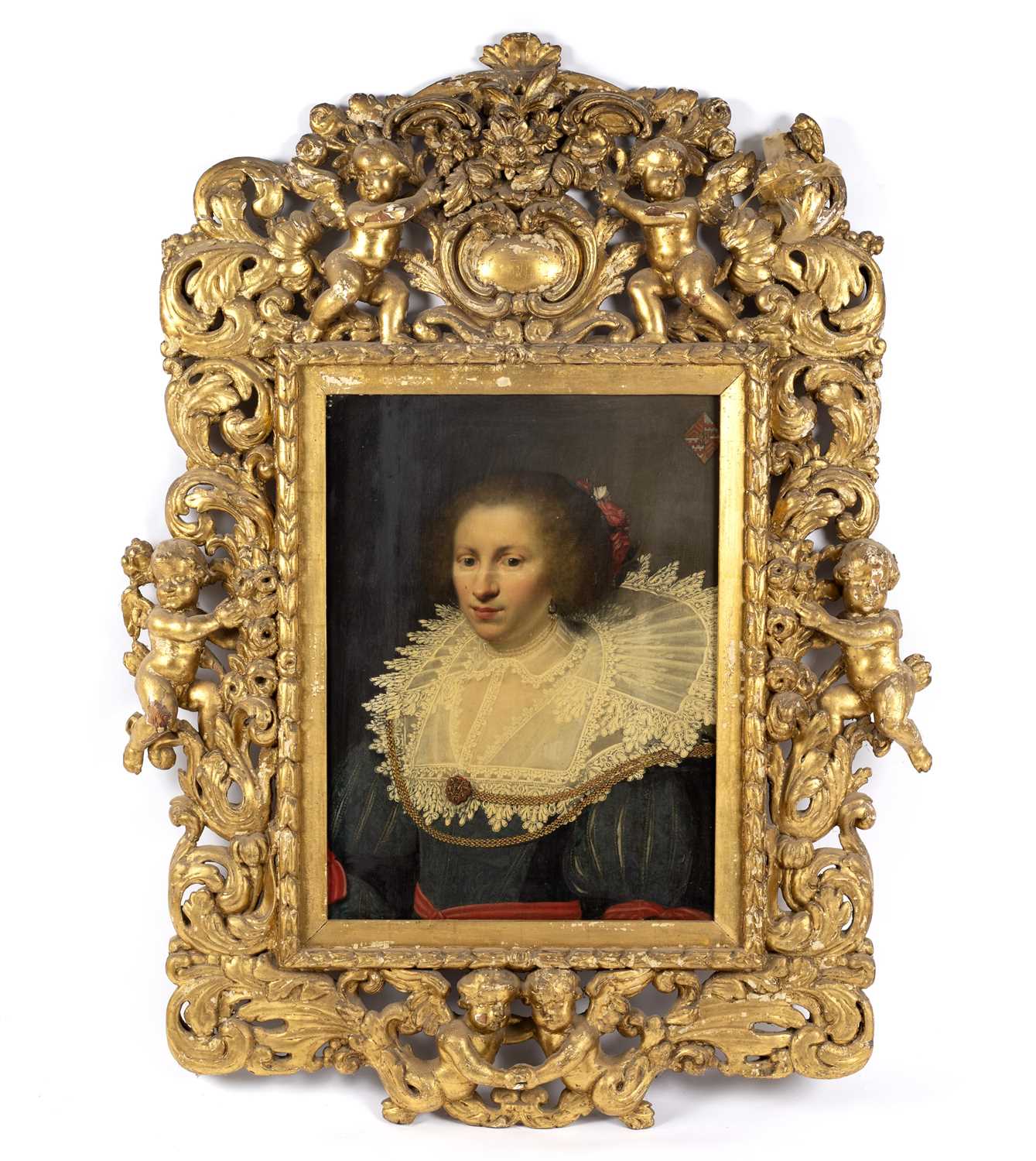28th Jan, 2020 10:00
Spetchley Park | The Attic Sale
89
Circle of Paulus Moreelse (Dutch 1571-1638)/Portrait of a Lady/half-length, wearing a black dress with pink ribbons and a fine lace collar/crested upper right/oil on panel, 63.5cm x 45.75cm /in a fine 17th Century carved and gilded frame with cherubs and putti in scrolling leafage/see illustration//Note: The armorial at the top right of this portrait is painted within a diamond-shaped 'lozenge' indicating the arms of a lady, and the smaller central escutcheon 'in pretence' shows that she is an heiress and a widow. Although the identity of the sitter cannot at present be confirmed, the armorial gives some clues as to her family and a likely attribution given below.
The principal coat, with the arms of her husband, is quartered. The first and fourth quarters with five red chevrons on a gold ground are recorded for the family of Abrincis, Avranches or Averinges of Folkestone in Kent. [Rietstap's Armorial Général informs further that at the time of the Conquest the bearer of these arms also held a feudal barony as 'Comte de Chester'; Hugh d'Avranches was one of the great magnates of Norman England.]
The second and third quarters Argent two bars embattled gules on the principal coat are of more interest. These were borne originally by the Haestrecht family, from a Lordship of that name near Utrecht. This gives a direct link with the painter Paulus Moreelse (1571-1638) who worked most of his life in Utrecht, being particularly noted for his portraits during the 1620s. Roger, son of Jacob van Haestrecht, fled to England in the 1560s to escape religious persecution, calling himself first Roger Jacobs and then Roger James, becoming a successful and wealthy London brewer. His third son, by his wife Sarah Morskyn of Liège, was William James (1570-1627) who in 1598 married Jane Kule (1582-1659) daughter and sole heir of Hendrick Kuel of Bremen (becoming after 1562 Henry Kule, brewer of London) and his wife Johanna Demaistres of a wealthy Antwerp family. About 1607 William James acquired the manor of Ightham Court in Kent and, leaving several children, William died there in April 1627 (leaving 'to ye poor People of Ightham 12 penny loaves every Sunday for ever' in recognition of his blessings). His wife Jane remained a widow for thirty-two years. The Kule arms do not appear recorded (and the Anglo/Flemish family name is spelled a number of ways) but this may well be her portrait.
Both families and their numerous relatives by marriage retained strong Dutch links and were associated with the Dutch Reformed Church, Austin Friars, who hold extensive records. The Dutch James family, later becoming Grevis-James, remained at Ightham Court through eight generations until 1920 (Our thanks go to Angela Howard for her help with researching this lot)/Provenance: Private collection, Gloucestershire
Sold for £11,000
Circle of Paulus Moreelse (Dutch 1571-1638)/Portrait of a Lady/half-length, wearing a black dress with pink ribbons and a fine lace collar/crested upper right/oil on panel, 63.5cm x 45.75cm /in a fine 17th Century carved and gilded frame with cherubs and putti in scrolling leafage/see illustration//Note: The armorial at the top right of this portrait is painted within a diamond-shaped 'lozenge' indicating the arms of a lady, and the smaller central escutcheon 'in pretence' shows that she is an heiress and a widow. Although the identity of the sitter cannot at present be confirmed, the armorial gives some clues as to her family and a likely attribution given below.
The principal coat, with the arms of her husband, is quartered. The first and fourth quarters with five red chevrons on a gold ground are recorded for the family of Abrincis, Avranches or Averinges of Folkestone in Kent. [Rietstap's Armorial Général informs further that at the time of the Conquest the bearer of these arms also held a feudal barony as 'Comte de Chester'; Hugh d'Avranches was one of the great magnates of Norman England.]
The second and third quarters Argent two bars embattled gules on the principal coat are of more interest. These were borne originally by the Haestrecht family, from a Lordship of that name near Utrecht. This gives a direct link with the painter Paulus Moreelse (1571-1638) who worked most of his life in Utrecht, being particularly noted for his portraits during the 1620s. Roger, son of Jacob van Haestrecht, fled to England in the 1560s to escape religious persecution, calling himself first Roger Jacobs and then Roger James, becoming a successful and wealthy London brewer. His third son, by his wife Sarah Morskyn of Liège, was William James (1570-1627) who in 1598 married Jane Kule (1582-1659) daughter and sole heir of Hendrick Kuel of Bremen (becoming after 1562 Henry Kule, brewer of London) and his wife Johanna Demaistres of a wealthy Antwerp family. About 1607 William James acquired the manor of Ightham Court in Kent and, leaving several children, William died there in April 1627 (leaving 'to ye poor People of Ightham 12 penny loaves every Sunday for ever' in recognition of his blessings). His wife Jane remained a widow for thirty-two years. The Kule arms do not appear recorded (and the Anglo/Flemish family name is spelled a number of ways) but this may well be her portrait.
Both families and their numerous relatives by marriage retained strong Dutch links and were associated with the Dutch Reformed Church, Austin Friars, who hold extensive records. The Dutch James family, later becoming Grevis-James, remained at Ightham Court through eight generations until 1920 (Our thanks go to Angela Howard for her help with researching this lot)/Provenance: Private collection, Gloucestershire
Auction: Spetchley Park | The Attic Sale, 28th Jan, 2020


